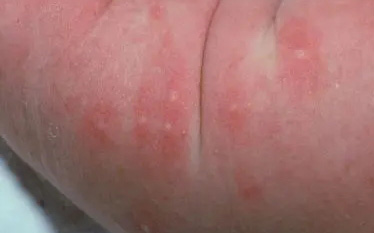Erythema Toxicum: Symptoms, Prevention, Treatment - Explained by Dr. Yeung Ho Hong(楊浩康)

Symptoms of toxic erythema of the newborn
Despite its alarming name, neonatal toxic erythema—also known as "fetal fire" or "fetal toxin" by older generations—is actually a common and benign skin phenomenon in newborns. Typically appearing within 3 to 4 days after birth, the baby’s skin develops tiny papules, about the size of a pinhead, which may be white or yellow and are surrounded by a ring of redness. These lesions most frequently occur on the cheeks, torso, back, and limbs, while rarely affecting the palms or soles. Although their appearance might be worrisome at first glance, they represent a normal part of the skin’s maturation process and do not require any special treatment.
Causes of toxic erythema in neonates
The exact cause of neonatal toxic erythema is not fully understood. Some studies suggest that after birth, as the infant’s skin is exposed to environmental microorganisms and stimuli, an immature immune response within the hair follicles may be triggered, leading to a localized inflammatory reaction. Given that a newborn’s skin has not yet fully developed its immune defenses—and that sebum production and shedding are still immature—this reaction is temporary and self-limiting, usually resolving on its own within a few days to a few weeks.
However, the term “toxic” in the condition’s name often causes unnecessary alarm among parents. A common misconception is that these skin changes indicate a serious infection or systemic poisoning, leading some to resort to overusing topical medications or making frequent hospital visits. In reality, neonatal toxic erythema does not cause pain, itchiness, or significant discomfort, nor does it compromise the overall health of the infant. Routine skin care is sufficient, and parents should refrain from squeezing or scratching the lesions to avoid potential skin damage or secondary infections.
For instance, one parent described a case where their baby developed tiny papules, each surrounded by a mild erythematous halo, on the cheeks and back on the fourth day after birth. Initially, the parent was extremely concerned, fearing a severe condition; however, after consultation with a pediatrician, it was clarified that this is a normal transitional phenomenon. With proper care and vigilant observation, the symptoms gradually faded away over the following days, and the baby continued to thrive. Such cases are frequently observed in clinical practice and reinforce that this condition is indeed a self-limiting and benign process.
Moreover, doctors emphasize that neonatal toxic erythema is an indication that the baby’s skin is in the process of transitioning from the protective in-utero environment to one capable of mounting an effective response against external challenges. As the sebaceous and sweat glands mature and the skin barrier strengthens, these transient papules naturally disappear without leaving any permanent marks. Parents are encouraged to maintain regular, gentle skin cleansing routines using warm water and mild baby cleansers.
In summary, although neonatal toxic erythema may sound alarming by name, it is merely a temporary and harmless skin condition. Parents should remain calm and monitor their baby’s skin, as the symptoms typically resolve within a few days or weeks without intervention. If the redness or papules persist or are accompanied by other unusual signs, timely consultation with a pediatrician or dermatologist is advisable to ensure the infant’s continued skin health and overall well-being. Recognizing this condition as a normal, transient part of newborn development can alleviate parental anxiety and help ensure a smoother parenting journey.
